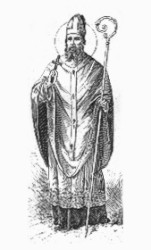Augustine of Canterbury
Augustine of Canterbury († May 26, 604 traditionally or - after William Thorne - 605 ) was the first Archbishop of Canterbury . He was sent by Pope Gregory I to Æthelberht , King of Kent in southern England , in 597 , accompanied by Lawrence of Canterbury , later the second Archbishop. He is considered the "apostle of the Anglo-Saxons". Augustine was canonized ; His feast day is May 27th in the Roman Catholic Church and May 26th in the Evangelical, Anglican and Orthodox Churches . He is not to be confused with the better known church father Augustine of Hippo .
Life
Æthelberht's wife Bertha , the daughter of the Merovingian king Charibert I , was a Christian. She had brought her chaplain Liudhard with her to the island to build a church in Canterbury or to have one restored from Roman times, which she consecrated to St. Martin of Tours , one of the main patrons of the Frankish royal family. Æthelberht himself was a pagan , but allowed his wife to practice her Christian religion. Probably under their influence, Æthelberht asked Pope Gregory to send missionaries to his kingdom.
Gregory's choice fell on the Benedictine monk Augustine, who in 596 was head (praepositus) of the Andrew monastery in Rome , which Pope Gregory himself had founded. He sent him out at the head of 40 monks to proselytize among the Anglo-Saxons , and a second time when Augustine returned to Rome after a half-hearted start and asked the Pope to give up the mission. Augustine was ordained bishop on the way in the Franconian Empire . In the spring of 597 Augustine and his companions landed on the Isle of Thanet .
Æthelberht allowed the missionaries to settle in Canterbury and preach there. Tradition says that Augustine baptized him only a few days after his arrival in Kent, although a letter from Gregory to Bertha suggests that this could not have happened before the year 601.
Æthelberht sent a report on his success to Gregor with questions about his work. In the year 601 Mellitus , Justus and others brought the papal answer with the pallium for Augustine (that is, the appointment as archbishop), sacred vessels, clothing, relics, books. Gregory ordered the new archbishop to ordain twelve auxiliary bishops as soon as possible, to send a bishop to York who was also to have twelve auxiliary bishops - a plan that was not carried out, nor to take the archbishopric in London , as did Gregory intended. Augustine made Mellitus Bishop of London and Justus Bishop of Rochester .
On the other hand, the Pope's orders regarding pagan temples and customs could be implemented: the former should become Christian churches, the latter, as far as possible, rededicated into martyrs' feasts , since "those who want to climb to lofty heights do not have to climb gradually jump ”(Letter from Gregory to Mellitus, in Beda , i, 30).
Augustine had an old church in Canterbury rebuilt as his cathedral, rededicated and founded a monastery. A second monastery was St. Peter and St. Paul outside the city walls. This Benedictine abbey was later, in 978, dedicated to Augustine, who has now been canonized.
His attempts to take over the Celtic Church in Wales failed.
presentation
Augustine of Canterbury is usually represented as a bishop ; Representations as a monk are rarer.
literature
- Friedrich Wilhelm Bautz : Augustin of Canterbury. In: Biographisch-Bibliographisches Kirchenlexikon (BBKL). Volume 1, Bautz, Hamm 1975. 2nd, unchanged edition Hamm 1990, ISBN 3-88309-013-1 , Sp. 272.
- Augustine of Canterbury in the Ecumenical Lexicon of Saints
- Augustine of Canterbury in the Catholic Encyclopedia
Web links
- Augustine on the diocese side
- Marko Rösseler: May 26th, 604 - anniversary of the death of Augustine of Canterbury WDR ZeitZeichen (podcast).
Individual evidence
- ↑ See AH Davis: William Thorne's Chronicle of Saint Augustine's Abbey, Canterbury. Oxford 1934.
| predecessor | Office | successor |
|---|---|---|
| - |
Archbishop of Canterbury 597–605 |
Laurentius |
| personal data | |
|---|---|
| SURNAME | Augustine of Canterbury |
| BRIEF DESCRIPTION | first Archbishop of Canterbury |
| DATE OF BIRTH | 6th century |
| DATE OF DEATH | May 26, 604 |

